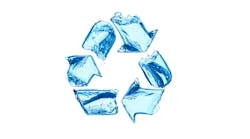Q: We are having trouble with the silica content of our RO + EDI system. The silica content in the raw water is 50 ppm. After the RO it is about 15 ppm. Currently our EDI system module must be replaced every seven months due to silica fouling. What is the correction for this problem?
— Jakarta, Indonesia
A: Silica in water can be colloidal, ionic (also called reactive) or a mixture of the two.
RO can remove practically all the colloidal silica and well over 97 percent of the reactive silica. Your RO does not appear to be doing this very effectively. UF membranes can also remove the colloidal, but not the reactive silica. Ion exchange cannot remove colloidal silica except, perhaps, by physically trapping some of it.
Often, reactive silica is removed by strong base anion exchange resin regenerated with sodium hydroxide. Your EDI, having the capability of removing both cations and anions, is providing this function. The EDI should not have much silica in its feedwater due to the expected removal of both silica and other ions by the RO. The silica in the EDI feedwater should be at or less than 0.5 ppm. It should be viewed as a polisher with a very low conductivity feed.
I suggest that you review your system with the manufacturer(s), including such parameters as residence time in the EDI, feedwater pH (it should be high to maintain solubility), antiscalants and especially percent recovery of the RO. You can increase silica removal significantly by lowering the percent recovery. Also review the type of membranes you have to be sure they are of the highest quality.
The RO appears to be the problem here so focus attention on it.
Q: I am in the process of building my fourth restaurant. Our most important product is coffee. We have been around for over 13 years. Consequently, we have spent a lot of time and money on experimentation. We currently use a RO system in two of our locations. Even they are not exactly what we want.
Since we are now under construction I want to take a different approach this time. I want to determine the ideal water characteristics for each piece of equipment and then choose the treatment.
I have a good idea what we need for our coffee, but I also want to determine water quality for dishwashers, ice machines and our steam generating equipment.
I am currently waiting for the results of a water sample we sent off for analysis and I know that our decisions of what we need will be based on what comes back.
For our coffee brewing equipment we strive for the following water characteristics: A TDS of 150 ppm (our range is 125-175); hardness of 68 ppm with a range of 30 to 85; total alkalinity of 40 ppm; pH 7.0; sodium at or near 10 ppm; and no chlorine or chlorinates. One of the challenges in today”s specialty coffee world is to determine how much of each mineral would help make the perfect cup.
Do you know what the water characteristics (TDS, hardness, alkalinity, etc.) would be ideal for the following?
- Ice machines: Goal is good taste, low maintenance and clear color.
- Low temperature commercial dishwashers: (Minimum of 140 degrees needed) Goal is to reduce glassware scaling, glassware hazing and tank scaling.
- Water heater: Goal is to reduce tank scaling and prolong life.
- Steam generating equipment: Our espresso machine has two boilers: One for coffee and one for generating steam for milk frothing. The water going to the boiler that is used for coffee is conditioned as per our specs and is good. However, the feed going to the boiler that produces steam should have different characteristics with the goal of producing better steam and minimizing mineral buildup.
Note: I assume that zero minerals (almost distilled water) would be great for the steam generating equipment, but then heard that it may actually harm the metal in the steam generating equipment? Can you address this? Any help and insight you provide would be greatly appreciated.
— Washington, D.C.
A: You have quite a few questions here and I”ll have to start by saying that I”m better at creating the correct water for an application when I”m told what quality is needed than I am at knowing what each piece of equipment needs. A water analysis would also have helped.
However, I can make some useful generalizations for you. Your coffee brewing water indicates that you have a good handle on this. I assume that your water supply is a municipal one and is the same for each location. This is good. I”m a little surprised that you want hardness in the brewing water, but I”m thinking that while it may cause some scaling in the brewer, it is a trade-off you are willing to make in order to have some hardness in the coffee.
In general, soften feedwater to any equipment that heats water to prevent hardness scaling (coffee brewing excepted). Hardness scale always occurs very rapidly at higher temperatures. This includes both the heating equipment and all plumbing that follows it. Soft water is ideal for dishwashers but be sure to use a minimum of detergent in order to prevent glass “etching,” which is a common phenomenon and occurs because most detergents are made for all water, including very hard water and consequently are very aggressive. When used with soft water they can damage glassware quickly. This is a permanent condition and is often confused with mineral “deposits.” Deposits can be scraped off or removed with acid. Generally, just using less detergent works very well.
Consider RO for the ice machines to reduce cloudiness. You can”t eliminate cloudiness with some machines because trapped air may stay in the cube, making it look cloudy. Many machines have a rinse cycle to rid the surface of the cube of minerals where they collect … away from the source of the cold. I would consider using the same water here as for the coffee. Also consider RO to reduce the scale buildup in steam equipment, both espresso and steam tables. This scale is not only hardness but all the minerals in the water — all 150 ppm of TDS. You can get very close to distilled water quality. Whether you can damage the steam equipment with low TDS water depends on what materials are present. Copper and iron could be a problem. Obviously an all-stainless steel system will be best.
You mention chlorine but I don”t think there”s such a species as “chlorinates.” You might mean chlorides or chloramines. Chlorides are part of the TDS and I can”t see where they would pose a problem. Chlorine and chloramine are disinfectants added by the municipal treatment plant. Activated carbon filters remove chlorine. Carbon blocks and catalytic activated carbon remove chloramines. I would remove these from all beverages. Removal from other water doesn”t seem to have any merit.
David M. Bauman, CWS-VI, CI, CCO, is technical editor of Water Technology® and a water treatment consultant in Manitowoc, Wis. He received his B.A. from the University of Illinois in Industrial Design. He can be reached by email at: [email protected].
For past articles in this column and related articles, go to www.WaterTechOnline.com and enter keyword “Professor” in the search box. To pose a question to “Professor POU/POE,” go to www.watertechonline.com, click “Ask the Professor” and follow the instructions.

